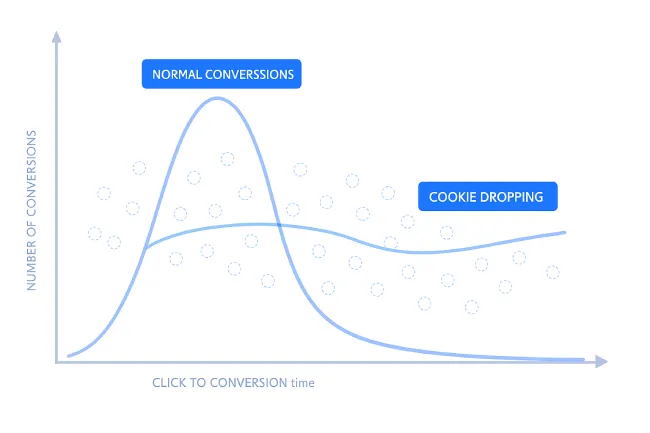Introduction
Click Spam, known also as cookie dropping, is a deceptive tactic where fraudsters generate a high volume of fake clicks to illegitimately claim credit for user conversions. This practice inflates click metrics without delivering genuine user engagement, leading to skewed analytics and wasted advertising budgets.

Understanding Click Spam
In click spam schemes, malicious actors simulate user clicks, often through automated scripts or bots, to create the illusion of legitimate traffic. These fraudulent clicks are typically generated without the user’s knowledge and can occur before any actual user interaction with an ad or app. The goal is to have these fake clicks attributed to real user conversions, thereby earning unmerited commissions or payouts.
Identifying Click Spam
Key indicators of click spam include:
- Abnormal Click-to-Conversion Times: Unusually long intervals between the recorded click and the subsequent conversion suggest that the click did not originate from genuine user interest.
- High Click Volumes with Low Engagement: A surge in click counts without a corresponding increase in meaningful user interactions or conversions.
- Inconsistent User Behavior Patterns: Discrepancies in user session data, such as rapid clicks from the same IP address or device, can signal fraudulent activity.
Preventing Click Spam

To combat click spam, implement the following strategies:
- 24Metrics advanced fraud and tracking tools: Utilize algorithms and behavioral analysis to detect and filter out fraudulent clicks in real-time.
- IP and Device Monitoring: Track and analyze IP addresses and device identifiers to identify patterns consistent with click fraud.
- Set Conversion Time Thresholds: Establish acceptable time frames between clicks and conversions to flag anomalies.
- Regular Data Audits: Conduct frequent reviews of traffic and conversion data to identify and address irregularities promptly.
Configuring Click Spam Filter
When setting up click spam detection mechanisms, in order to prevent any false flaggings, there are various filter presets for most common use that will use thresholds and configurations to match Ecommerce, Lead Gen, Mobile App Installs and many more activities:
- Threshold percentage to determine acceptable ranges for click-to-conversion times and click volumes.
- Minimum conversion count
- Maximum session time allowed in hours
- Lookback Time from 12 hours up to 30 days
